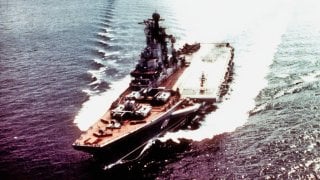Kiev-Class: Russia's Great Aircraft Carrier Mistake?
The sale of the Kiev-class aircraft carriers by Russia, in light of the prolonged repairs of the Admiral Kuznetsov leaving Russia without an operational carrier, raises questions about whether it was a shortsighted decision.
Summary: The sale of the Kiev-class aircraft carriers by Russia, in light of the prolonged repairs of the Admiral Kuznetsov leaving Russia without an operational carrier, raises questions about whether it was a shortsighted decision or even a clear mistake. The Kiev-class, introduced as the Soviet Navy's first fixed-wing aircraft carrier, was designed as a "heavy aviation cruiser" to circumvent the Montreux Convention restrictions. Featuring a mix of aircraft carrier and cruiser characteristics, these vessels were pivotal for various naval warfare tasks. Despite their unique capabilities, the decision to sell was driven by financial necessity and strategic considerations, reflecting Russia's lack of need for far-reaching naval air power. With the carriers sold to China and India either decommissioned or repurposed, maintaining them would likely have been unfeasible for Russia, making the sale a pragmatic choice given the circumstances.
The Strategic Calculus Behind Russia's Sale of Kiev-Class Carriers
Did the Russians make a mistake when they sold of their Kiev-class aircraft carriers? The fact that Russia’s lone remaining aircraft carrier, the Admiral Kuznetsov, has been under repairs for several years leaving the Russians functionally aircraft carrier-less, retrospectively makes the decision to sell the Kiev-classes seem shortsighted. But hindsight is always clearer, and really, if the Russians still possessed the Kiev’s, something likely would have gone wrong by now.
Introducing the Kiev-class
The Kiev-class was the first fixed-wing aircraft carrier ever used in the Soviet Navy. First laid down in 1970, the Kiev was originally intended to be a supercarrier comparable to the American Kitty Hawk. But the Soviets, mindful of costs, scaled back their ambitions and designed a more modest boat, the Kiev.
The Kiev is odd in that, unlike NATO aircraft carriers, the Kiev combines features of both the aircraft carrier and the cruiser. Actually, the Soviet designation for the Kiev was a “heavy aviation cruiser,” rather than “aircraft carrier.” The designation was strategic: under the Montreux Convention of 1936, aircraft carriers weighing more than 15,00 tons were prohibited from passing through the Turkish Straits. But a heavy aviation cruiser, on the hand, was welcome to pass the Straits at will.
The vessel featured a distinctive design – with a pronounced island superstructure to starboard and an angled flight-deck two-thirds the length of the total deck. The remaining one-third of the deck, the foredeck, was bristling with surface-to-air and surface-to-surface missiles. The heavy armament was intended to support the Kiev complete her intended mission: supporting ballistic missile submarines, surface ships, and naval aviation. Accordingly, the Kiev could engage in antiaircraft, antisubmarine, and surface warfare.
In sum, the Kiev measured 896 feet long with a 174-foot beam and a 33-foot draught. Between 1,200 and 1,600 sailors manned the vessel, which was propelled with 8 turbo-pressurized boilers and four steam turbines – enough to achieve a respectable 32 knots per hour.
The Kiev could accommodate up to 30 aircraft, including 12 Yak-38 VTOL fighter and 16 helicopters.
The Soviet’s completed four Kiev-class carriers. The Russians discarded all four. Two were sold to China. One was scrapped after an engine room fire. And one was sold to India. So, should the Russians have held onto their Kiev-class?
Holding onto the Kiev
The likelihood that the Russians could have kept their Kiev-class carriers in service in the forty years since making the sales seems unlikely. Remember, neither of the two carriers sold to the Chinese are still in service; one is a naval museum, while the other has been developed into a luxury hotel. The Indian sale, now under the moniker INS Vikramaditya, is the only Kiev still in active duty. Let’s assume that the boats sold to the Chinese would have suffered similar fates if kept in Russia’s possession. Maybe not the luxury hotel part, but the decommissioned part. Russia does not have a great track record of maintaining aircraft carriers.
Russia knew what they needed when they sold their boats. They needed the cash more than the boats. Strategically, the Russians knew they didn’t have any far-reaching ambitions and didn’t need to be a maritime people, projecting airpower abroad. The Russians knew then, as they know now, that their carriers were money pits, and they didn’t have the resources to maintain the fleet. The lack of money and the lack of strategic need combined to suggest that selling the Kiev-class was a reasonable decision.
About the Author: Harrison Kass
Harrison Kass is a defense and national security writer with over 1,000 total pieces on issues involving global affairs. An attorney, pilot, guitarist, and minor pro hockey player, Harrison joined the US Air Force as a Pilot Trainee but was medically discharged. Harrison holds a BA from Lake Forest College, a JD from the University of Oregon, and an MA from New York University. Harrison listens to Dokken.


